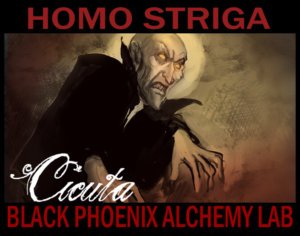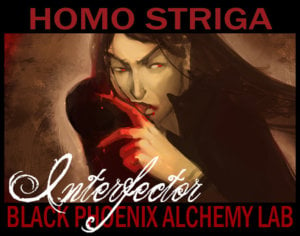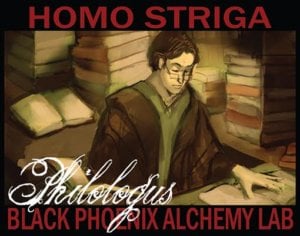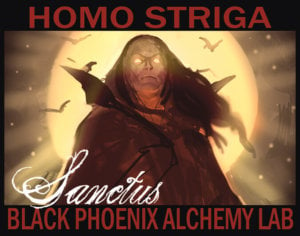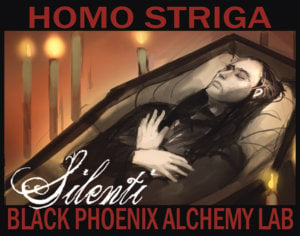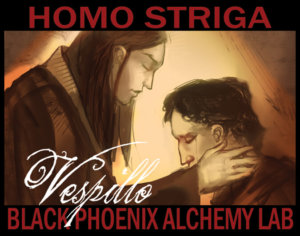VILF
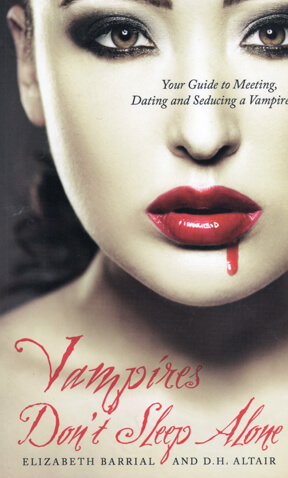 The Vampires Don’t Sleep Alone Collection
The Vampires Don’t Sleep Alone Collection
Presented in an amber apothecary glass vial.
Because of the nature of this project, imps are not available for any Vampires Don’t Sleep Alone scents
Vampires Don’t Sleep Alone: Your Guide to Meeting, Dating and Seducing a Vampire
by Elizabeth Barrial and D.H. Altair
Last year, Del Howison and I were hired to write a tongue-in-cheek guide to dating vampires. Essentially, the premise of the book assumes that vampires are real and that they have recently come out of the crypt, so to speak. It explores the potential challenges found in actually dating vampires, and touches on the anthropology and science of vampires. We shelved most of the supernatural tropes, and concentrated on painting as “realistic” a picture as possible. I wrote the deadpan pseudoscience and false history, Del added warmth, contemporary advice, and wit. The project went through many iterations. It was initially supposed to be geared towards teen readers, and then the concept morphed to appeal to a more mature audience. I’m really, really happy with the way that we tweaked the vampire mythos.
In the end, after months of research, innumerable conversations, eleventybillion rewrites, and much love and tears, the book went to the editor… and here we are.
This is my first time writing in this capacity, with publishers and all that snazzy stuff, and it was a nerve-wracking, wonderful, educational, and exciting experience. I want to thank Del (from the bottom of my heart!) and the people at Ulysses Press for this opportunity, and I hope that our book does them proud!
I finished your book last night. I now know more about vampires than I knew there was to know. I’m also very impressed. The book is extremely well-written, with healthy doses of wit, irony and much intelligence.
—Karl Alexander, author of Time After Time
Purchase Vampires Don’t Sleep Alone from Amazon.
There have been quite a few scholars and historians among the vampire population, and over the centuries, repositories of their collective knowledge have been established all over the globe, the most notable libraries being in Vienna, Baghdad, Madrid, Kiev, Venice, Kyoto, Santo Domingo, Damascus, Thebes, and Detroit, though their specific locations remain shrouded in secrecy. Even in the twenty-first century, there is still very little trust between Homo sapiens and Homo striga, and vampires generally feel safer keeping their information among their own kind, so it is almost impossible for non-vampires to access the historical records. From time to time, however, information does leak out, and the following is partially based on Valentina Luzio’s dissertation on intercultural vampire stereotypes, but it has also been pieced together through information we have gleaned through conversations with our vampire associates.
Over the centuries, vampires have classified their own kind, and in the past, these classifications became the root of a rough caste system that some vampires still adhere to today. For the most part, though, the terms are now used as loose slang, similar to the way that humans have coined phrases to describe those who share related predilections, tastes, and behaviors. The terms of vampire classification that we have come across are Cicuta, Interfector, Tombeur, Silenti, Transeo, Philologi, Misericordia, Vespillo, and Sanctus.
-
Cicuta Perfume Oil
Add to cartThe Cicuta, also called the Rictus, are least likely to be accepted by human society, and are, sadly, also the least likely to be accepted by other vampires in general. Some vampires have a peculiar adverse reaction to the transference of the vampiric pathogen whereby their physical appearance is drastically altered: They lose their hair, their features become elongated, their eyes protrude, and a permanent and irreversible inflammation of their joints causes stiff movement and a clawlike rigidity in the hands and feet. Cicuta minds function as any other vampire’s, but their appearance is so startlingly different that they find it almost impossible to find any acceptance whatsoever among humans or vampires. Usually these afflicted vampires choose to live in isolation, either on secluded estates or literally underground. Occasionally, small groups of Cicutas can be found cohabitating, finding comfort and companionship with those that share their condition. The Cicuta were parodied somewhat in F. W. Murnau’s 1922 film Nosferatu.
Dry, dusty rose petals, candle smoke, frankincense, and saffron.
-
Interfector Perfume Oil
Add to cartThere are two types of vampires that humans, and often other vampires, need to be wary of: the Interfectors and the Tombeur. The Interfectors are ruthless killers, ultimate hunters who view humans as livestock. They are brutal, but not necessarily cruel, and rarely toy with their prey. Universally, Interfectors perceive their transition into the vampiric state to be an initiation into a higher state of being, not transcendent or spiritual in nature, but rather a promotion to the top of the food chain.
Ruthless, unfeeling, and inhumanly violent: tobacco, sharp woods, frankincense, and bunn.
-
Misericordia Perfume Oil
Add to cartThe Misericordia, or Tristis, are vampires that are consumed with a longing to regain their lost humanity, some to the point of being driven mad by the desire to be human once more. The shock of their transition into vampirism and the rejection they faced from friends and loved ones was devastating, and it compromises their ability to find solace and comfort. Unlike the Transeo, Misericordia cannot merge into human society, but are relegated by their own grief to the position of outsiders. Their inherent melancholy and morose temperaments make it difficult for them to cultivate relationships with either humans or vampires. Most vampires treat the Misericordia with a fair amount of derision, and they are sometimes hunted by Interfectors who see the perspective of the Misericordia as an affront to their way of thinking.
Eons of grief and unending hunger: magnolia, black currant, castoreum accord, lavender, labdanum, amber, rose otto, and opoponax.
-
Philologus Perfume Oil
Add to cartThe Philologi are scholars and philosophers that have dedicated themselves to the pursuit of knowledge, utilizing their extended lifespan to further their research. They are usually reclusive, and some were once Transeo that have rejected the bustle of human society in favor of solitude.
Ancient books, crackled parchment, faded incense, and candle wax.
-
Sanctus Perfume Oil
Add to cartThe Sanctus are considered by some pious vampires to be the saints of their kind, and from what we have gleaned, they are very likely the stuff of myth. These vampires are paragons that possess impossible, phenomenal powers that defy known physics, including the ability to shift shape, turn into a gaseous form, and command other vampires through will alone. The mythological Sanctus are venerated by some, but we have no evidence whatsoever that they truly exist.
Diabolically otherworldly: golden osmanthus, lily of the valley, celestial musk, and frankincense.
-
Silenti Perfume Oil
Add to cartThe Silenti reject human society completely, and are, quite literally, the living dead. Either due to trauma, sociopathic psychological conditions they possessed while human, or through a desire to embrace this peculiar aesthetic, they adopt many of the stereotypes and trappings of the vampire-as-undead. Some act as monstrous killers, akin to the murderous ways of Interfectors, while others are more peaceable, but no less strange. Most of these vampires choose to live in crypts, haunting graveyards like proverbial ghouls. Many vampire death cults have sprung from the philosophies and writings of Silenti, including the House of Azrael, whose members venerate death itself as the supreme deity and oblivion as heaven.
Grave beauty: Spanish moss, lilac, wisteria, myrrh, and olibanum.
-
Tombeur Perfume Oil
Add to cartThere are two types of vampires that humans, and often other vampires, need to be wary of: the Interfectors and the Tombeur.
The Tombeur, are much more complex in their hunting habits and their perceptions than their Interfector cousins. Like the Interfectors, they perceive their vampirism to be an initiation into a higher state of being and relegate humans to base foodstuffs. Unlike the Interfectors, however, the Tombeur are not straightforward predators, and there is a secondary purpose to their hunt: sexual gratification. They take full advantage of their saliva’s hypnotic and psychotropic effects on humans, the mystique that surrounds vampires, the seemingly unnatural attraction some humans have toward vampires, and the potency of the Tombeurs’ own sexual drive to lure humans into complex carnal relationships that culminate in feeding. They are consummate seducers, and some Tombeur feed, completely and terminally, on their conquests, while others create henchmen that are little more than sex slaves. Neither fate is something we would recommend to any of our readers.
Deadly and seductive: vanilla-infused sandalwood, blood musk, antique patchouli, vetiver, lavender, bitter almond, amber, and a trickle of Snake Oil.
-
Transeo Perfume Oil
Add to cartThe Transeo are vampires that have assimilated into human society, often reaching positions of power. Among the Transeo there are many celebrated politicians, scientists, businessmen, philosophers, artists, writers, and musicians, and, surprisingly, a large number of influential clergy and militarists. Not every Transeo is an illustrious public figure; many simply desire the comforts associated with reentering society. In the past, most Transeo posed as humans as best they could, concealing their true natures. In the twenty-first century, more and more Transeo are coming out in the open, and they form the backbone of most vampire-acceptance movements.
GA cologne that (almost) blends well into human society: benzoin, orange blossom, cumin, King mandarin, gaiac wood, juniper berry, Calabrian bergamot, Ceylon cinnamon, and blood camouflaged by wine.
-
Vespillo Perfume Oil
Add to cartThe Vespillo are dedicated to assisting newly infected vampires in understanding and accepting their condition and learning to live with the challenges that vampires face. Vespillo, like the Transeo, tend to become members of vampire-acceptance movements, pushing for a wider understanding of vampires among the human population.
A grounded, earthy scent, evocative of the soul’s finer qualities: patchouli, clove, neroli, night-blooming jasmine, sage, and iris.
